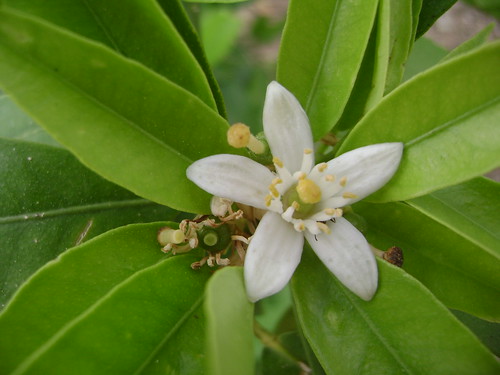Aphrodisiac of the Day: Orange Blossom
"When Adar comes in - happiness is increased" (mi'she'nichnas Adar marbin be'simcha).
Adar is the 6th month of the Jewish calendar (or the last... Depending if you start counting from Rosh Hashana or Passover!), and it's when Purim is celebrated. It also has a very close name to the Hebrew name for citrus - Hadar.
And - low and behold - it's also the season for citrus to bloom in the Mediterranean region where I come from. At this time of the year - end of March and all through April - orange flowers and all things citrus permeate the air with their euphoric aroma, making even the gloomiest of souls feel all cheerful and optimistic.
Orange blossoms are a long-known aphrodisiacs, and they are the only flower I've chosen for the series this year, because although they are an exquisite and costly perfume, they are also readily available in their edible version: orange flower water. These are be readily sought at most Middle Eastern, Greek and Persian as well as East Indian grocers, and should be stored in the fridge of every foodie and perfumista and anyone seeking for pure natural beauty. I use these beautiful waters to spritz on my face every night (and also in the morning or during the day when it's really dry - for example: when traveling by air). The fragrance is reviving, soothing and will make you feel 400% better than before applying it... Use it on its own after you cleansed or simply washed your face with water; or before applying your usual hydrating concoctions (I use my own handmade facial elixir of nourishing botanical oils).
All citrus blossoms smell heavenly, but the species used for perfume are from Citrus aurantium - the same tree that provides us with bitter orange peel oil (through expression of the zest), petitgrain bigarade (steam distillation of the leaves, twigs and often also the buds), and Neroli (the steam distilled essential oil of the same flowers). Furthermore, the distillate water (orange flower water) which I have just mentioned are processed with a solvent to produce an unusual product called orange flower water absolute. It's a most resourceful tree, as you can see!
The absolute is floral and citrusy all at once, but richer, sweeter and warmer than the fresh and innocent, honeyed Neroli. It is opulent, intoxicating and considered one of the "white florals" along with tuberose, ylang ylang, jasmine and narcissus.
Orange blossom absolute shares some qualities with jasmine absolute (due to presence of both indole and methyl anthranilate) and is round, soft and slightly tart - in my opinion is very true to the fresh orange blossoms, with some herbaceous and rich, honeyed undertones. It is an extremely versatile essence, and is used in both Oriental and floral compositions for women, where it's luscious, narcotic floral qualities are accentuated; and is also a wonderful floral for masculine scents as well as fresh and dry Eau de Cologne types.
Orange flowers have been traditionally used to scent bridal bouquets, and Neroli perfume was "prescribed" to brides on their white-wedding night to reduce the stress and anxiety before losing their virginity. It's relaxing and stress-relieving qualities are also put into use with children - in the south of France children drink a concoction of steamed milk with honey and orange flower hydrosol to induce a restful sleep.
At another time, neroli was used so often by Italian prostitutes, that the smell became extremely associated with promiscuity (similarly to how White Musk has become in the 80's and 90's)... Thankfully, those days are over and we can enjoy orange blossom's seductive qualities with no negative associations.
There are countless recipes for orange flower water in desserts and beverages. It is widely used in various Middle Eastern pastries (baklava) and spoon desserts (Malabi), not to mention many halva and various East Indian sweets. Another creative way to use orange flower is in fruit salads (try it over strawberries or cantaloupe!) and even in vegetable salad vinigraitte for a refreshing yet surprisingly floral aroma.
Aphrodisiac perfumes containing notable amounts of orange blossom: Amaranthine (Penhalligon's), Bois d'Hiver, Chinatown (Bond No. 9), Fleurs d'Oranger (Serge Lutens), Jean Paul Gautier Classique, Jitterbug (Opus Oils), La Chasse aux Papillon (l'Artisan Parfumeur), For Her (Narciso Rodriguez), Obsession (Calvin Klein), Opium (YSL), Orchid (Aftelier), Parfum Privé (Aftlier), Popy Moreni, Private Collection (Estee Lauder), Razala, Schizm, Silences (Jacomo), Tolu (Ormonde Jayne), Vent Vert (Balmain), Zohar




